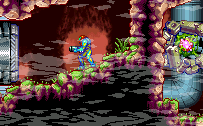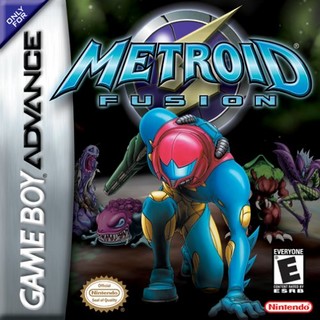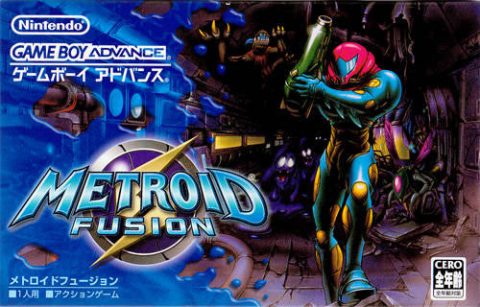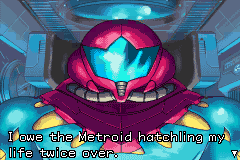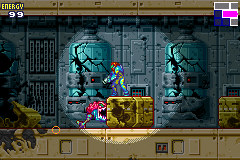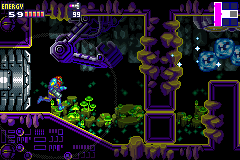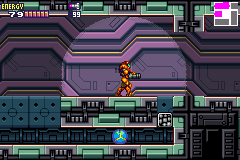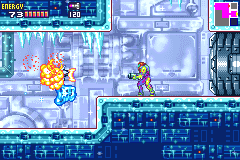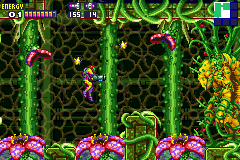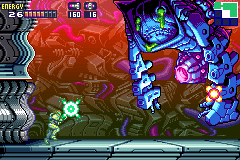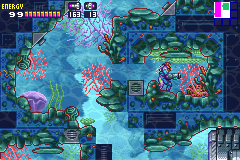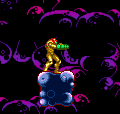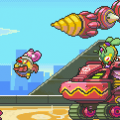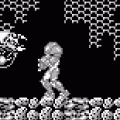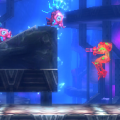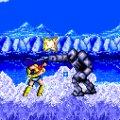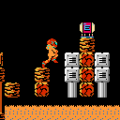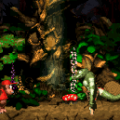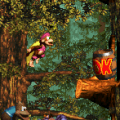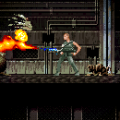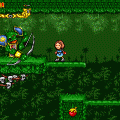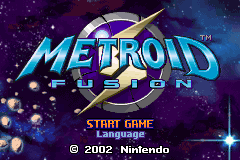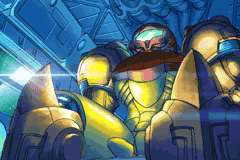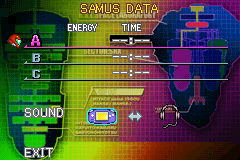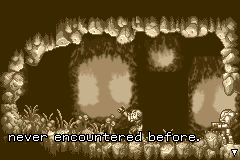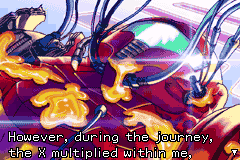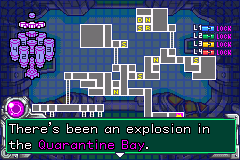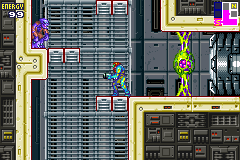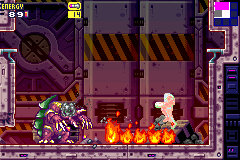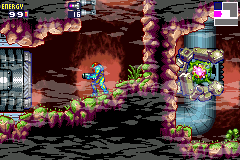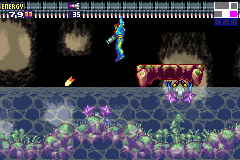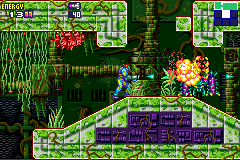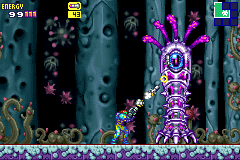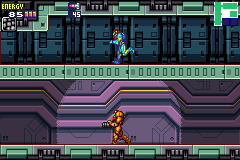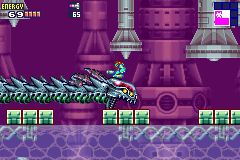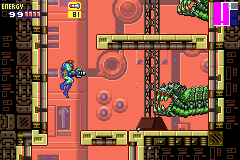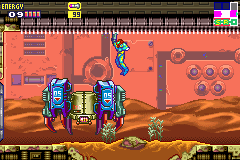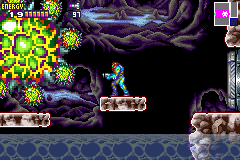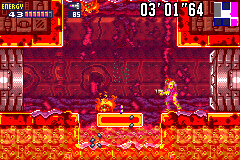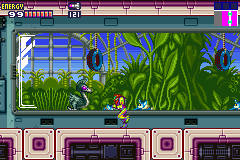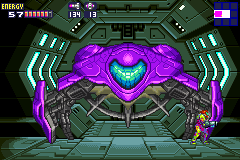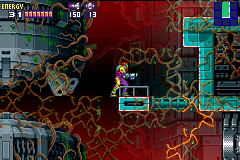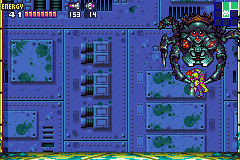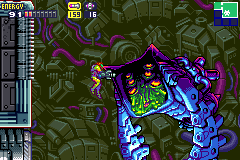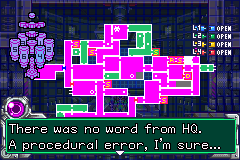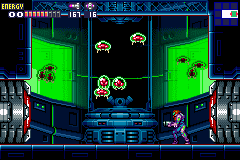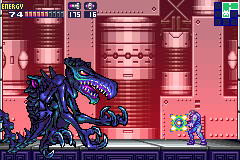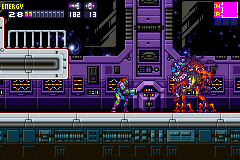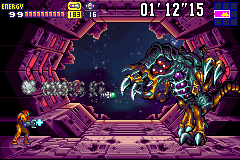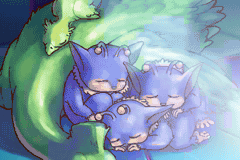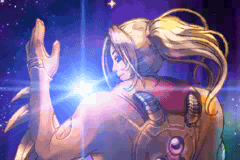The Metroid series skipped the Nintendo 64 era, so they made up it in 2002 with the release of two Metroid titles on the same day. One of them was Metroid Prime, a fully 3D first person shooter developed by the American team Retro Studios, which at the time was met with skepticism. The other was Metroid Fusion, a 2D game for the Game Boy Advance made by Nintendo in Japan, including being directed by Yoshio Sakamoto and developed by some of the same staff as Wario Land 4. It was a glorious day of riches, though no one could’ve expected that the 3D “foreign” version was actually more faithful to the spirit of the old games than the Japanese one, which eschews much of the exploration in favor of a focus on action and storytelling.
After Samus’ exploits in the previous games, the Metroids have basically been entirely wiped out from SR388. This has an unfortunate side effect though – they were the natural predators of the X virus, who have since proliferated and infected Samus. Almost near death, she is only saved thanks to an injection of Metroid DNA. As she leaves the facility, she receives another distress call – while she is cured, theX has run rampant throughout the Federation research station, infecting and destroying anything that comes near it. Since Samus is essentially vaccinated against the virus, she’s immune to its effects, and is called back to contain it and save the day once again. Since she’s in a weakened state, she begins with few of her powers, and must upgrade her arsenal and abilities by either visiting Data rooms administered by the Federation’s computer, or by killing the bosses that absorbed her powers. There are colored hatches, but they are unlocked via security rooms, rather than being opened by weaponry.
The game plays similar to Super Metroid, but with a number of tweaks and control enhancements, many due to the lesser amount of buttons on the Game Boy Advance, but most of which work in its favor. You no longer need to hit the Select button to cycle through weapons – just hold down the R button to activate missiles, then fire. Similarly, hold R when in Morph Ball mode to drop super bombs. Super Missiles are equipped automatically when you get them and don’t consume any different (or more) ammo than normal, they’re just more powerful. There’s no dash button, as Samus naturally walks a little faster, and power dashes automatically when building up enough speed. The nicest addition is the ability to grab onto ledges, which makes platforming much easier.
However, not everything was carried over from Super. The grappling hook is gone, as is the X-ray Visor (Super Bombs have an effect of showing some hidden stuff). Some of the more unusual abilities, like the dropping several bombs after charging your weapon, as well as the Crystal Flash healing skill, are gone too. You can’t de-select obtained power-ups either, though there’s not really any reason to here, since all weapons are just upgrades of your current one anyway. Reserve tanks are gone too, as they probably seemed redundant.
There’s now an additional piece of lore added to the canon – given that the only way to kill Metroid larva in previous games was to freeze them, it’s revealed that they are cannot survive at low temperatures. And with Samus’ DNA now being part-Metroid thanks to the vaccine, she’s now susceptible to cold as well. Because of this, Samus can’t use a regular Ice beam, so instead you get Ice missiles, which are easier to use. This aspect is fairly quickly forgotten, though, once you obtain the power-up that lets her survive in low temperatures.
Now, Super Metroid had an intro text scroll, but it was fairly short, and any further text basically disappeared until the ending. In Fusion, this type of narration is constant throughout. Samus is paired up with an AI commander, who she names Adam after a previous compatriot of hers, who will instruct her to next goal. The flow is: find a navigation room, get your orders, find the goal, and then report back for more orders. You’re rarely allowed to deviate from this, either. Furthermore, the ship has a central hub, and is divided into six discrete habitats – SR-388, Tropical, Aquatic, Arctic, Pyro, and Nocturnal – each accessed via a central elevator. It makes logical sense, but it’s so orderly that it removes the sense of one big interconnected world. Plus, the navigation room also gives a map layout, and while it doesn’t always pinpoint the exact location you need to go (the “security” rooms which open locks are off the map, so your commander says), you rarely need to explore very much. This is compared to Super Metroid, which had map rooms but also made you wander around before you found them.
Super Metroid was restrictive at points, but it also organically led you in the right direction, and let you wander off course if you wanted. Fusion barely gives you any such freedom. It does work mostly in the same manner though, in that it will often stick you in small areas and force you to look for hidden stuff in order to advance. This results in far less opportunities for sequence breaking, though there are a couple, one of which the designers even anticipated and including a hidden message from Adam if you achieve it.
To be fair, Fusion gives less and less direct guidance as the game goes one. You’ll often be led back into previously visited habitats, and need to explore all of the areas well outside of the mapped area. Plus, even though it’s not displayed, there are times where you break through the walls of the habitats and enter others outside of the main elevator, so the worlds are (slightly) connected. But it never feels like you’re really off the game’s leash. Even at the finale, it denies you the ability to explore the rest of the ship before the final encounter, because it simply locks off where you’re not supposed to go (unless you know about this event beforehand and specifically avoid it in order to avoid getting railroaded into the conclusion). You can always reload your save after you’ve beaten it to continue to explore, but it’s still annoying.
And a lot of this in service of the narrative, mostly in personifying the X virusas ever present antagonist. How do you anthropomorphize a virus? Easy – by making it like the baddie from The Thing, the 1982 movie by John Carpenter, in allowing it to absorb and take whatever shape it wants. Here, X takes some of the power suit parts discarded during the medical procedure that saved Samus’ life, and basically turns itself into an evil Samus clone called the SA-X. What’s more, is that the procedure left Samus in a different suit, with a sort of off-kilter coloring. Here, the SA-X basically looks as Samus is supposed to look, so the “real” looking one is in fact the evil one.
The best moments of the game are when you encounter the SA-X. The AI commander warns you, under no circumstances are you to engage it, because it will absolutely destroy you. And it’s not lying – any of the few times where the SA-X pop ups, the music stops, and the only thing you can hear are its echoing footsteps. At some points, you just need to sit still until it passes; in others, you need to stun it and scramble past it in order to find a hiding place, and eventually safety. These situations are always harrowing, but there are also moments where, like Super, it plays with Metroid series conventions to take you by surprise, like one part when the electricity is cut and you’re stuck on an elevator between zones.
The game is also more action focused. Both Samus and the enemies move faster, and enemy attacks inflict more damage. To counterbalance this, every defeated foe will unleash a form of the virus, which can absorbed by Samus to either increase health or missiles, depending on its color. If you’re not quite enough, this virus can either spawn new enemies, or mutate current ones into stronger forms, an element which is occasionally used to solve some puzzles.
In general, the game really isn’t that much harder, except for the boss fights, most of which are substantially more difficult than the other 2D games. In many of those cases, simply having enough health or missiles was enough to defeat him, but here, you really need to understand their patterns in order to uncover their vulnerabilities. The most harrowing battle against Nightmare, a biomechanical being whose weakpoint is so precariously placed that you need to coax it into the right position to be able to attack it consistently without taking damage. There’s also a battle against Nettori, which recalls the fight against Mother Brain in the original game, except in a plant-like environment. Once you kill a boss, you’ll also need to deal with the virus that infects them. These are rarely too difficult (they’re mostly the same with some variations throughout), especially given that they’ll give off health and missile replenishments if you hit them, but they can prove troublesome if you only survived the fight through the skin of your teeth, as they can still kill you if you’re not careful.
However, the battles actually get easier as the game goes on. You’ll encounter Ridley here, whose corpse has been frozen, but the encounter is extremely simple. For all of the build-up of how powerful the SA-X is, the actual fight against it is rather rote. And you get to fight an Omega Metroid right at the end, but perhaps because it’s under a time limit, it goes down too quickly.
A special mention must be made of both the graphics and the spritework. Compared to the other Metroid games, which all took place on dark planets, Fusion takes place on a space station – a common trope in other sci-fi games, but given the different biomes of the facility, gives it more visual variation. Owing to the lack of a backlight on the original GBA models, the visual style is also much brighter and colorful. The boss designs are all fantastic too, especially the creepy Nightmare, whose faces slowly begins oozing as you knock off its armor.
The music is a substantially different style than Super Metroid, though it’s suitably atmospheric in its own way, despite the typically low GBA quality. The only downside is that the main theme, a heroic little tune, is played a little too often. You’ll hear it consistently when traveling into different areas, and it only changes to that area’s theme after exploring a bit.
The main issue with Metroid Fusion is the same one for every beloved franchise which deviates from an established formula. Since the earlier Metroid games were so focused on exploration, if you take so much of that away, is it really a Metroid game? The game still looks and feels like one, plus the focus on action and storytelling generally works in its favor, so the change isn’t entirely bad. Still, it can’t help feel like a small disappointment. There’s a sense that the developers didn’t really like how open ended the previous games were, especially for younger players, and wanted to create something specifically for them, rather than series veterans. This is even seen in the way that the computer asks you if you understand each and every objective (if you say no, it simply repeats itself).
However, the disappointment can largely be felt due to the circumstances of its release. At the time, there were very few other similar games, outside of the portable Castlevania games that Konami was releasing. In the subsequent years, the Metroidvania subgenres became more popular, especially in the Western indie development scene, making these games more prevalent, especially seeing how they embrace the exploratory titles of the older games rather than shying away from it. In that context, Fusion’s flaws are more forgivable, since it’s just a different take on the formula. Still, this focus on action and narrative predicated the game’s follow-up from Nintendo’s Japanese branch, Metroid: Other M, which was met with much more disappointment.
Owing to the series’ overseas popularity (and launching simultaneously with Metroid Prime for the holiday season), Metroid Fusion was actually released in North America, Europe, and Australia first. The Japanese release, published a few months later in early 2003, adds in both easier and harder difficulty modes. Additionally, as in previous games, you get different pictures of Samus, either in our out of her power suit, based on both your item found percentage and your completion time. These were drawn by Kenji Ishikawa, who also illustrated the manga being serialized in Monthly Magazine Z at the time. Some of the enemy names are different too: Serris is Ishtar, Pogo is Zazapi, and Yakuza is Geduu. There’s also a “Kid’s” mode which re-writes the dialogue to use less kanji. The Kid’s mode has different pictures for the ending that were added specifically for the Japanese version. Beating Metroid Fusion and connecting it to the Gamecube via system link will unlock a few things in Metroid Prime: an emulated version of the NES version of Metroid, as well as an optional Fusion suit skin for the main game.
